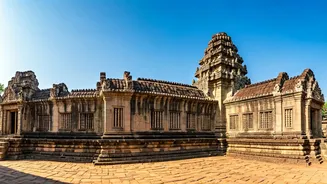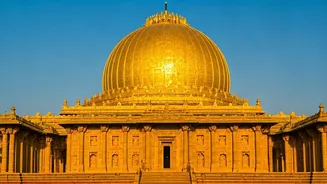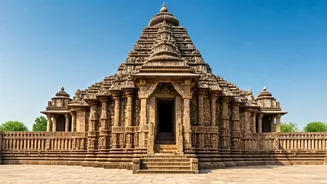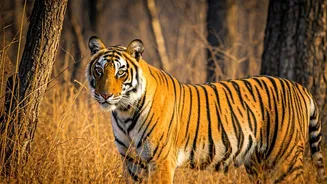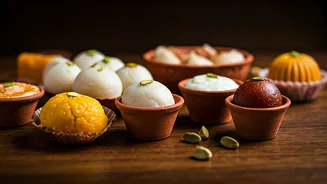Konark Sun Temple
The Konark Sun Temple, located in Odisha, is a prime example of Kalinga architecture, dedicated to the sun god, Surya. Built in the 13th century, its design
resembles a colossal chariot with twelve pairs of wheels, pulled by seven horses. The temple's intricate carvings depict various aspects of life, including mythological stories, daily activities, and ornate sculptures. The temple's strategic placement allowed sunlight to illuminate the inner sanctum at dawn, showcasing a unique blend of art and astronomy. This UNESCO World Heritage site is a testament to the Kalinga dynasty's prowess in art, architecture, and engineering.
Modhera Sun Temple
In Gujarat, the Modhera Sun Temple stands as a masterpiece of Solanki architecture, dating back to the 11th century. This temple is famous for its exquisitely carved stepwell, the Surya Kund, and its unique design that allows the sun's rays to fall directly on the deity during the equinoxes. The temple is divided into three main parts: the Surya Kund (reservoir), Sabha Mandapa (assembly hall), and the Guda Mandapa (shrine). The carvings narrate stories from the Ramayana, Mahabharata, and Puranas, demonstrating the artistic abilities and religious beliefs of the Solanki rulers. The temple's strategic design ensured that the first rays of the sun would illuminate the idol on specific days.
Martand Sun Temple
The Martand Sun Temple, now in ruins, is located in Jammu and Kashmir. Constructed in the 8th century, it showcases the influence of Kashmiri architecture. Although partially destroyed in subsequent conflicts, the ruins still offer glimpses of its former grandeur, highlighting the temple's imposing scale and intricate carvings. The temple's design includes a colonnaded courtyard, a main shrine, and surrounding smaller shrines, reflecting a harmonious integration of local and global architectural traditions. The grandeur of Martand Sun Temple represents a blend of architectural styles, influenced by the Gupta and Chinese traditions, and signifies the rulers' spiritual devotion.
Sun Temple, Deo
The Deo Sun Temple, situated in Bihar, is a lesser-known yet remarkable site dedicated to the sun god. It is particularly revered for its unique architecture and the religious significance attached to it. The temple's construction is characterized by the use of black stone and features intricate carvings. It's believed that the image of the sun god at this temple is unique. The temple hosts the Chhath Puja festival, attracting thousands of devotees, and reflects the local religious practices and the enduring faith of the people in the sun god, Surya.
Surya Pahar, Assam
Surya Pahar in Assam is another important site housing multiple rock-cut sculptures dedicated to various deities, including the sun god, Surya. It is located on a hilltop, allowing panoramic views of the surrounding landscape, highlighting the spiritual significance of the area. The site's archaeological richness, including rock-cut sculptures of Hindu, Buddhist, and Jain traditions, suggests a history of religious harmony and cultural exchange. This location exemplifies a convergence of diverse religious influences, showcasing a remarkable synthesis of spiritual elements within its architectural framework, making it a compelling spot for history and spirituality enthusiasts.
